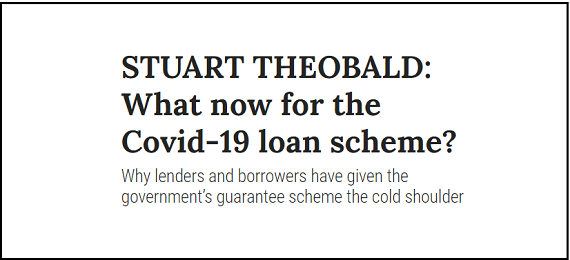Lending through the scheme has remained dismal even though big changes were implemented at the end of July to make it easier for borrowers and banks to use it. But since two weeks ago just R16.08bn had been lent, not even R5bn more than when the changes were made. It is clear now that the scheme won’t get anywhere near the R200bn target.
Despite this poor performance, the scheme is regularly touted as a big part of the R500bn recovery plan, including in last week’s economic recovery plan speech by President Cyril Ramaphosa.
What has gone wrong? I think there are several issues.
First, the banks themselves have not found the scheme particularly attractive. In part that’s because it costs a 0.5% fee to use it. In return, banks get a guarantee in that the government will cover any defaults beyond the first 6% plus any margin earned. In the first year, the government covers roughly 92%, then 90% in the second year and so on decreasing for the six years of repayment period.
This would have been a useful risk mitigator for the banks if the economy was in far bigger trouble than it is. But the credit outlook has turned out to be more benign, at least so far. So why pay 0.5% to get insurance that you don’t need?
This was hard to predict at the time the scheme was initially set up. I argued then that banks should be required to commit to certain lending targets (much like they do under their BEE charter). The decision on whether to commit to insurance should be made at the time when the risks are unclear, rather than down the road when it may not be needed. The scheme design effectively granted banks an option that is now out of the money.
Second, a structural flaw in the scheme is that no specific amount was budgeted to cover losses. The R200bn headline figure is deeply misunderstood. This was a number the Reserve Bank was committed to lending to banks through its discount windows to finance the loans. In other words, the Reserve Bank was going to “print money” but then take it back from the banking sector as loans were repaid. This was a clever way of using money creation as part of the emergency economic response. But it is not some pile of government money waiting to be spent, as some assume.
Because the Reserve Bank cannot take any risk, the National Treasury underwrites the guarantee (though any profits the central bank makes absorbs losses first). So, if there is a loan default, the Treasury takes it over and repays the Bank.
The problem is that the Treasury never put a specific number on the table for how much it was budgeting. Internally, numbers like R15bn were talked of, but because this was not a formal budget, one couldn’t calibrate the scheme to ensure that it was met. If the design approach had been “Here’s R15bn, let’s calibrate the rules so that we get that amount of losses while maximising the amount lent” there would have been a different design. Plus, the figure of R15bn would have stuck in the public mind rather than R200bn.
Third, the banks have not shown great enthusiasm for the scheme, even aside from the fee. There has been a marked divergence in bank appetite. By far the largest user has been Standard Bank. As at the end of June, the last period for which results are available, it had lent R8.3bn while Nedbank had lent R1.2bn, Absa R500m, and FirstRand R345m. The figures would have been far better if all banks had shown the enthusiasm that Standard had. It got to its numbers because it automated the assessment process for clients faster. Plus, the scheme loans it offered to clients were often cheaper than its normal loan offers.
Fourth, demand. A big problem is that the scheme became available about seven weeks after lockdown. By then distressed clients had accessed forbearance measures or made other plans to manage their finances. The scheme specifies that the credit assessments must be based on financial performance up to the end of 2019. The universe of clients that both performed then and wanted additional debt after lockdown is not that big. That market has now been exhausted.
What now? Debt is a stimulus lever that can be pulled only so far. Ultimately, interest rates are the driver of debt demand, and those are at or near the lowest they can get. A government scheme can’t drive debt demand much more, especially when the government can’t afford to take huge losses onto its balance sheet.
I expect we will see large-scale deleveraging by households and businesses as they adjust to the uncertain economic outlook. In 2008 when the financial crisis hit, SA households had record debt of 86.4% of annual income. That fell steadily to 71.9% in 2018 before recording its first post-crisis rise to 72.8% in 2019. The downward trend is now going to resume.
The president, however, is left with a political problem. The R200bn figure is nailed to the mast. There are efforts under way to think of potential reforms to the scheme, but I expect these will be fruitless.
What we need now is something fundamentally different, something that reduces risk for businesses. Interesting schemes are being developed by the Gauteng government, among others, to underwrite equity in businesses rather than loans. So far, these are small scale but are more like the sort of solutions we need.
Article Source: https://www.businesslive.co.za/bd/opinion/columnists/2020-10-18-stuart-theobald-what-now-for-the-covid-19-loan-scheme/





